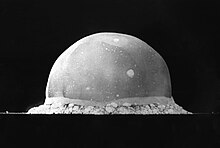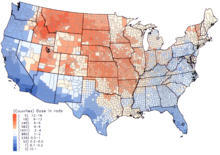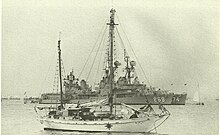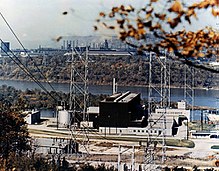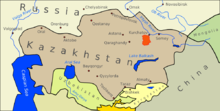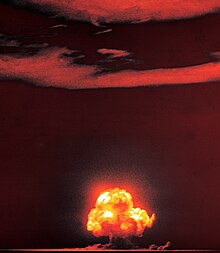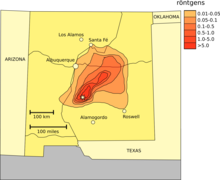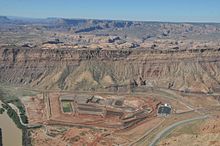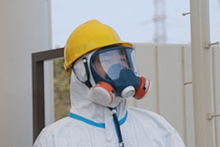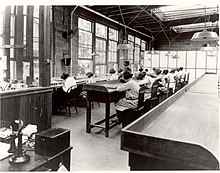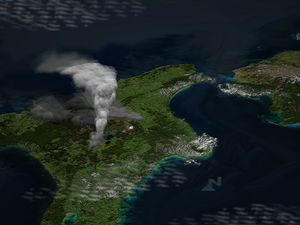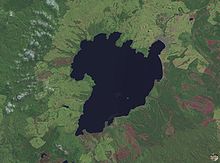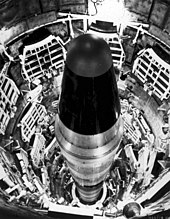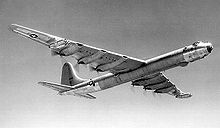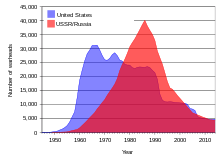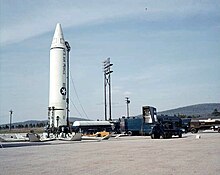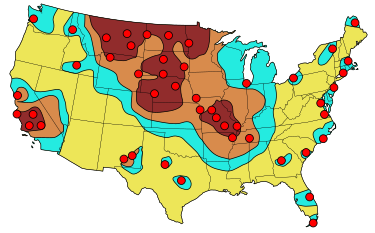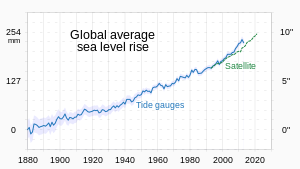From Wikipedia, the free encyclopedia
Nuclear warfare (sometimes
atomic warfare or
thermonuclear warfare) is a
military conflict or
political strategy in which
nuclear weaponry is used to inflict damage on the enemy. Nuclear weapons are
weapons of mass destruction; in contrast to
conventional warfare, nuclear warfare can produce destruction in a much shorter time and can have a long-lasting
radiological warfare result. A major nuclear exchange would have long-term effects, primarily from the
fallout released, and could also lead to a "
nuclear winter" that could last for decades, centuries, or even millennia after the initial attack. Some analysts
dismiss the nuclear winter hypothesis, and calculate that even with nuclear weapon stockpiles at
Cold War highs, although there would be
billions of
casualties, billions more rural people would nevertheless survive. However, others have argued that
secondary effects of a
nuclear holocaust, such as
nuclear famine and
societal collapse, would cause almost every human on Earth to starve to death.
After World War II, nuclear weapons were also developed by the
Soviet Union (1949), the
United Kingdom (1952),
France (1960), and the
People's Republic of China (1964), which contributed to the state of conflict and extreme tension that became known as the
Cold War. In 1974,
India, and in 1998,
Pakistan, two countries that were openly hostile toward each other, developed nuclear weapons.
Israel (1960s) and
North Korea
(2006) are also thought to have developed stocks of nuclear weapons,
though it is not known how many. The Israeli government has never
admitted or denied to having nuclear weapons, although it is known to
have constructed the reactor and reprocessing plant necessary for
building nuclear weapons.
South Africa also manufactured several complete nuclear weapons in the 1980s, but subsequently became
the first country to voluntarily destroy their domestically made weapons stocks and abandon further production (1990s). Nuclear weapons have been detonated on over 2,000 occasions for
testing purposes and demonstrations.
Types of nuclear warfare
The
possibility of using nuclear weapons in war is usually divided into two
subgroups, each with different effects and potentially fought with
different types of nuclear armaments.
The first, a
limited nuclear war (sometimes
attack or
exchange),
refers to a small-scale use of nuclear weapons by two (or more)
belligerents. A "limited nuclear war" could include targeting military
facilities—either as an attempt to
pre-emptively
cripple the enemy's ability to attack as a defensive measure, or as a
prelude to an invasion by conventional forces, as an offensive measure.
This term could apply to
any small-scale use of nuclear weapons that may involve military or civilian targets (or both).
The second, a full-scale nuclear war, could consist of
large numbers of nuclear weapons used in an attack aimed at an entire
country, including military, economic, and civilian targets. Such an
attack would almost certainly destroy the entire economic, social, and
military infrastructure of the target nation, and would probably have a
devastating effect on Earth's biosphere.
Some
Cold War strategists such as
Henry Kissinger argued that a limited nuclear war could be possible between two heavily armed superpowers (such as the
United States and the
Soviet Union). Some predict, however, that a limited war could potentially "
escalate" into a full-scale nuclear war. Others
have called limited nuclear war "global nuclear holocaust in slow
motion", arguing that—once such a war took place—others would be sure to
follow over a period of decades, effectively rendering the planet
uninhabitable in the same way that a "full-scale nuclear war" between
superpowers would, only taking a much longer (and arguably more
agonizing) path to the same result.
Even the most optimistic predictions
of the effects of a major nuclear exchange foresee the death of many
millions of victims within a very short period of time. More pessimistic
predictions argue that a full-scale nuclear war could potentially bring
about the
extinction of the human race, or at least its
near extinction, with only a relatively small number of survivors (mainly in remote areas) and a reduced
quality of life and
life expectancy for centuries afterward. However, such predictions, assuming
total war with nuclear arsenals at
Cold War highs, have not been without criticism.
Such a horrific catastrophe as global nuclear warfare would almost
certainly cause permanent damage to most complex life on the planet, its
ecosystems, and the global climate.
A study presented at the annual meeting of the
American Geophysical Union in December 2006 asserted that even a small-scale regional nuclear war could produce as many direct fatalities as all of
World War II
and disrupt the global climate for a decade or more. In a regional
nuclear conflict scenario in which two opposing nations in the
subtropics
each used 50 Hiroshima-sized nuclear weapons (c. 15 kiloton each) on
major population centers, the researchers predicted fatalities ranging
from 2.6 million to 16.7 million per country. The authors of the study
estimated that as much as five million tons of
soot could be released, producing a cooling of several degrees over large areas of North America and
Eurasia
(including most of the grain-growing regions). The cooling would last
for years and could be "catastrophic", according to the researchers.
Either a limited or full-scale nuclear exchange could occur during an
accidental nuclear war,
in which the use of nuclear weapons is triggered unintentionally.
Postulated triggers for this scenario have included malfunctioning early
warning devices and/or targeting computers, deliberate malfeasance by
rogue military commanders, consequences of an accidental straying of
warplanes into enemy airspace, reactions to unannounced missile tests
during tense diplomatic periods, reactions to military exercises,
mistranslated or miscommunicated messages, and others. A number of these
scenarios actually occurred during the Cold War, though none resulted
in the use of nuclear weapons. Many such scenarios have been depicted in
popular culture, such as in the 1959 film
On the Beach, the 1962 novel
Fail-Safe (released as a film in 1964); the film
Dr. Strangelove or: How I Learned to Stop Worrying and Love the Bomb, also released in 1964; the film
WarGames, released in 1983.
History
1940s
Atomic bombings of Hiroshima and Nagasaki
Mushroom
cloud from the atomic explosion over Nagasaki rising 18,000 m
(59,000 ft) into the air on the morning of August 9, 1945.
During the final stages of
World War II
in 1945, the United States conducted atomic raids on the Japanese
cities of Hiroshima and Nagasaki, the first on August 6, 1945, and the
second on August 9, 1945. These two events were the only times nuclear
weapons have been used in
combat.
For six months before the atomic bombings, the U.S.
20th Air Force under
General Curtis LeMay executed low-level
incendiary raids against Japanese cities. The worst air raid to occur during the process was not the nuclear attacks, but the
Operation Meetinghouse raid on Tokyo. On the night of March 9–10, 1945,
Operation Meetinghouse commenced and 334
Boeing B-29 Superfortress bombers took off to raid, with 279 of them dropping 1,665 tons of
incendiaries and
explosives
on Tokyo. The bombing was meant to burn wooden buildings and indeed the
bombing caused fire that created a 50 m/s wind, which is comparable to
tornadoes. Each bomber carried 6 tons of bombs. A total of 381,300
bombs, which amount to 1,783 tons of bombs, were used in the bombing.
Within a few hours of the raid, it had killed an estimated 100,000
people and destroyed 41 km
2 (16 sq mi) of the city and 267,000 buildings in a single night — the deadliest bombing raid in
military aviation history other than the atomic raids on Hiroshima and Nagasaki. By early August 1945, an estimated 450,000 people had died as the U.S. had intensely firebombed a total of 67 Japanese cities.
In late June 1945, as the U.S. wrapped up the two-and-a-half-month
Battle of Okinawa (which cost the lives of 260,000 people, including 150,000 civilians), it was faced with the prospect of invading the Japanese home islands in an operation codenamed
Operation Downfall. Based on the U.S. casualties from the preceding
island-hopping campaigns,
American commanders estimated that between 50,000 and 500,000 U.S.
troops would die and at least 600,000–1,000,000 others would be injured
while invading the Japanese home islands. The U.S. manufacture of
500,000
Purple Hearts
from the anticipated high level of casualties during the U.S. invasion
of Japan gave a demonstration of how deadly and costly it would be.
President Harry S. Truman
realized he could not afford such a horrendous casualty rate,
especially since over 400,000 American combatants had already died
fighting in both the
European and the
Pacific theaters of the war.
On July 26, 1945, the United States, the United Kingdom, and the Republic of China issued a
Potsdam Declaration that called for the
unconditional surrender of Japan. It stated that if Japan did not surrender, it would face "prompt and utter destruction". The Japanese government
ignored
this ultimatum, sending a message that they were not going to
surrender. In response to the rejection, President Truman authorized the
dropping of the atomic bombs. At the time of its use, there were only
two atomic bombs available, and despite the fact that more were in
production back in
mainland U.S., the third bomb wouldn't be available for combat until September.
A photograph of Sumiteru Taniguchi's back injuries taken in January 1946 by a U.S. Marine photographer
On August 6, 1945, the uranium-type nuclear weapon codenamed "
Little Boy" was detonated over the Japanese city of
Hiroshima with an energy of about 15 kilotons of TNT (63,000 gigajoules), destroying nearly 50,000 buildings (including the
headquarters of the
2nd General Army and
Fifth Division) and killing approximately 70,000 people, including 20,000 Japanese combatants and 20,000 Korean slave laborers. Three days later, on August 9, a plutonium-type nuclear weapon codenamed "
Fat Man"
was used against the Japanese city of Nagasaki, with the explosion
equivalent to about 20 kilotons of TNT (84,000 gigajoules), destroying
60% of the city and killing approximately 35,000 people, including
23,200–28,200 Japanese munitions workers, 2,000 Korean slave laborers,
and 150 Japanese combatants.
The industrial damage in Nagasaki was high, partly owing to the
inadvertent targeting of the industrial zone, leaving 68–80 percent of
the non-dock industrial production destroyed.
Six days after the detonation over Nagasaki, Japan announced
its surrender to the
Allied Powers on August 15, 1945, signing the
Instrument of Surrender on September 2, 1945, officially ending the
Pacific War and, therefore, World War II, as
Germany had already signed its
Instrument of Surrender on May 8, 1945, ending the
war in Europe. The two atomic bombings led, in part, to
post-war Japan's adopting of the
Three Non-Nuclear Principles, which forbade the nation from developing nuclear armaments.
Immediately after the Japan bombings
We knew the world would not be the
same. A few people laughed, a few people cried, most people were silent.
I remembered the line from the Hindu scripture the Bhagavad Gita.
Vishnu is trying to persuade the prince that he should do his duty and
to impress him takes on his multiarmed form and says, "Now, I am become
Death, the destroyer of worlds." I suppose we all thought that one way
or another.
Immediately after
the atomic bombings of Japan, the status of atomic weapons in
international and military relations was unclear. Presumably, the United
States hoped atomic weapons could offset the Soviet Union's larger
conventional ground forces in Eastern Europe, and possibly be used to
pressure Soviet leader
Joseph Stalin
into making concessions. Under Stalin, the Soviet Union pursued its own
atomic capabilities through a combination of scientific research and
espionage
directed against the American program. The Soviets believed that the
Americans, with their limited nuclear arsenal, were unlikely to engage
in any new world wars, while the Americans were not confident they could
prevent a Soviet takeover of Europe, despite their atomic advantage.
Within the United States the authority to produce and develop
nuclear weapons was removed from military control and put instead under
the civilian control of the
United States Atomic Energy Commission.
This decision reflected an understanding that nuclear weapons had
unique risks and benefits that were separate from other military
technology known at the time.
For several years after
World War II, the United States developed and maintained a strategic force based on the
Convair B-36 bomber
that would be able to attack any potential enemy from bomber bases in
the United States. It deployed atomic bombs around the world for
potential use in conflicts. Over a period of a few years, many in the
American defense community became increasingly convinced of the
invincibility of the United States to a nuclear attack. Indeed, it
became generally believed that the threat of nuclear war would deter any
strike against the United States.
Many proposals were suggested to put all American nuclear weapons under international control (by the newly formed
United Nations, for example) as an effort to deter both their usage and an
arms race. However, no terms could be arrived at that would be agreed upon by both the United States and the Soviet Union.
American and Soviet nuclear stockpiles.
On August 29, 1949, the
Soviet Union tested its
first nuclear weapon at
Semipalatinsk in
Kazakhstan (see also
Soviet atomic bomb project).
Scientists in the United States from the Manhattan Project had warned
that, in time, the Soviet Union would certainly develop nuclear
capabilities of its own. Nevertheless, the effect upon military thinking
and planning in the United States was dramatic, primarily because
American military strategists had not anticipated the Soviets would
"catch up" so soon. However, at this time, they had not discovered that
the Soviets had conducted significant
nuclear espionage of the project from spies at Los Alamos, the most significant of which was done by the theoretical physicist
Klaus Fuchs. The first Soviet bomb was more or less a deliberate copy of the
Fat Man plutonium device. In the same year the first US-Soviet nuclear war plan was penned in the US with
Operation Dropshot.
With the monopoly over nuclear technology broken, worldwide nuclear proliferation accelerated. The
United Kingdom tested its first independent atomic bomb in 1952, followed by
France in 1960 and then
China
in 1964. While much smaller than the arsenals of the United States and
the Soviet Union, Western Europe's nuclear reserves were nevertheless a
significant factor in strategic planning during the
Cold War. A top-secret
White Paper, compiled by the
Royal Air Force
and produced for the British Government in 1959, estimated that British
bombers carrying nuclear weapons were capable of destroying key cities
and military targets in the Soviet Union, with an estimated 16 million
deaths in the Soviet Union (half of whom were estimated to be killed on
impact and the rest fatally injured)
before bomber aircraft from the U.S.
Strategic Air Command reached their targets.
1950s
Although the Soviet Union had nuclear weapon capabilities in the beginning of the
Cold War,
the United States still had an advantage in terms of bombers and
weapons. In any exchange of hostilities, the United States would have
been capable of bombing the Soviet Union, whereas the Soviet Union would
have more difficulty carrying out the reverse mission.
The widespread introduction of
jet-powered
interceptor aircraft upset this imbalance somewhat by reducing the effectiveness of the American bomber fleet. In 1949
Curtis LeMay was placed in command of the
Strategic Air Command and instituted a program to update the bomber fleet to one that was all-jet. During the early 1950s the
B-47 and
B-52
were introduced, providing the ability to bomb the Soviet Union more
easily. Before the development of a capable strategic missile force in
the Soviet Union, much of the war-fighting doctrine held by western
nations revolved around using a large number of smaller nuclear weapons
in a tactical role. It is debatable whether such use could be considered
"limited" however, because it was believed that the United States would
use its own strategic weapons (mainly bombers at the time) should the
Soviet Union deploy any kind of nuclear weapon against civilian targets.
Douglas MacArthur, an American general, was fired by President
Harry Truman,
partially because he persistently requested permission to use his own
discretion in deciding whether to utilize atomic weapons on the
People's Republic of China in 1951 during the
Korean War.
Mao Zedong,
China's communist leader, gave the impression that he would welcome a
nuclear war with the capitalists because it would annihilate what he
viewed as their "imperialist" system.
Let us imagine how many people
would die if war breaks out. There are 2.7 billion people in the world,
and a third could be lost. If it is a little higher it could be half ...
I say that if the worst came to the worst and one-half dies, there will
still be one-half left, but imperialism would be razed to the ground
and the whole world would become socialist. After a few years there
would be 2.7 billion people again.
— Mao Zedong, 1957
The U.S. and USSR conducted hundreds of nuclear tests, including the Desert Rock exercises at the Nevada Test Site, USA, pictured above during the Korean War
to familiarize their soldiers with conducting operations and
counter-measures around nuclear detonations, as the Korean War
threatened to expand.
The concept of a "
Fortress North America"
emerged during the Second World War and persisted into the Cold War to
refer to the option of defending Canada and the United States against
their enemies if the rest of the world were lost to them. This option
was rejected with the formation of NATO and the decision to permanently
station troops in Europe.
In the summer of 1951
Project Vista started, in which project analysts such as
Robert F. Christy looked at how to defend Western Europe from a Soviet invasion. The emerging development of
tactical nuclear weapons
were looked upon as a means to give Western forces a qualitative
advantage over the Soviet numerical supremacy in conventional weapons.
Several scares about the increasing ability of the Soviet Union's
strategic bomber forces surfaced during the 1950s. The defensive
response by the United States was to deploy a fairly strong "layered
defense" consisting of
interceptor aircraft and
anti-aircraft missiles, like the
Nike, and guns, like the
Skysweeper,
near larger cities. However, this was a small response compared to the
construction of a huge fleet of nuclear bombers. The principal
nuclear strategy
was to massively penetrate the Soviet Union. Because such a large area
could not be defended against this overwhelming attack in any credible
way, the Soviet Union would lose any exchange.
This logic became ingrained in American nuclear doctrine and persisted for much of the duration of the
Cold War.
As long as the strategic American nuclear forces could overwhelm their
Soviet counterparts, a Soviet pre-emptive strike could be averted.
Moreover, the Soviet Union could not afford to build any reasonable
counterforce, as the economic output of the United States was far larger
than that of the Soviets, and they would be unable to achieve "nuclear
parity".
Soviet nuclear doctrine, however, did not match American nuclear doctrine. Soviet military planners assumed they could win a nuclear war. Therefore, they
expected a large-scale nuclear exchange, followed by a "conventional war" which itself would involve heavy use of
tactical nuclear weapons. American doctrine rather assumed that Soviet doctrine was similar, with the
mutual in
Mutually Assured Destruction
necessarily requiring that the other side see things in much the same
way, rather than believing—as the Soviets did—that they could fight a
large-scale, "combined nuclear and conventional" war.
A revolution in nuclear strategic thought occurred with the introduction of the
intercontinental ballistic missile
(ICBM), which the Soviet Union first successfully tested in August
1957. In order to deliver a warhead to a target, a missile was much
faster and more cost-effective than a bomber, and enjoyed a higher
survivability due to the enormous difficulty of interception of the
ICBMs (due to their high altitude and extreme speed). The Soviet Union
could now afford to achieve nuclear parity with the United States in raw
numbers, although for a time, they appeared to have chosen not to.
Photos of Soviet missile sites set off a wave of panic in the U.S. military, something the launch of
Sputnik would do for the American public a few months later. Politicians, notably then-
U.S. Senator John F. Kennedy suggested that a "
missile gap"
existed between the Soviet Union and the United States. The US military
gave missile development programs the highest national priority, and
several
spy aircraft and
reconnaissance satellites were designed and deployed to observe Soviet progress.
Early ICBMs and bombers were relatively inaccurate, which led to the concept of
countervalue
strikes — attacks directly on the enemy population, which would
theoretically lead to a collapse of the enemy's will to fight. During
the Cold War, the Soviet Union invested in extensive protected civilian
infrastructure, such as large "nuclear-proof" bunkers and non-perishable
food stores. By comparison, smaller scale
civil defense
programs were instituted in the United States starting in the 1950s,
where schools and other public buildings had basements stocked with
non-perishable food supplies, canned water, first aid, and
dosimeter and
Geiger counter radiation-measuring devices. Many of the locations were given "
Fallout shelter" designation signs.
CONELRAD radio information systems were adopted, whereby the commercial radio sector (later supplemented by the
National Emergency Alarm Repeaters)
would broadcast on two AM frequencies in the event of a Civil Defense
(CD) emergency. These two frequencies, 640 and 1240 kHz, were marked
with small CD triangles on the tuning dial of radios of the period, as
can still be seen on 1950s-vintage radios on online auction sites and
museums. A few backyard
fallout shelters were built by private individuals.
Henry Kissinger's view on tactical nuclear war in his controversial 1957 book
Nuclear Weapons and Foreign Policy was that any nuclear weapon exploded in
air burst
mode that was below 500 kiloton in yield and thus averting serious
fallout, may be more decisive and less costly in human lives than a
protracted conventional war.
A list of targets made by the U.S.A. was released sometime during December 2015 by the U.S.
National Archives and Records Administration.
The language used to describe targets is "designated ground zeros". The
list was released after a request was made during 2006 by William Burr
who belongs to a research group at
George Washington University, and belongs to a previously
top-secret 800-page document. The list is entitled "Atomic Weapons Requirements Study for 1959" and was produced by U.S.
Strategic Air Command during the year 1956.
1960s
In 1960, the United States developed its first
Single Integrated Operational Plan,
a range of targeting options, and described launch procedures and
target sets against which nuclear weapons would be launched, variants of
which were in use from 1961 to 2003. That year also saw the start of
the
Missile Defense Alarm System,
an American system of 12 early-warning satellites that provided limited
notice of Soviet intercontinental ballistic missile launches between
1960 and 1966. The
Ballistic Missile Early Warning System was completed in 1964.
A complex and worrisome situation developed in 1962, in what is called the
Cuban Missile Crisis.
The Soviet Union placed medium-range ballistic missiles 90 miles
(140 km) from the United States, possibly as a direct response to
American
Jupiter missiles placed in
Turkey.
After intense negotiations, the Soviets ended up removing the missiles
from Cuba and decided to institute a massive weapons-building program of
their own. In exchange, the United States dismantled its launch sites
in Turkey, although this was done secretly and not publicly revealed for
over two decades.
Khrushchev
did not even reveal this part of the agreement when he came under fire
by political opponents for mishandling the crisis. Communication delays
during the crisis led to the establishment of the
Moscow–Washington hotline to allow reliable, direct communications between the two nuclear powers.
By the late 1960s, the number of ICBMs and warheads was so high
on both sides that it was believed that both the United States and the
Soviet Union were capable of completely destroying the infrastructure
and a large proportion of the population of the other country. Thus, by
some western
game theorists, a
balance of power system known as
mutually assured destruction (or
MAD)
came into being. It was thought that no full-scale exchange between the
powers would result in an outright winner, with at best one side
emerging the
pyrrhic victor. Thus both sides were
deterred from risking the initiation of a direct confrontation, instead being forced to engage in lower intensity
proxy wars.
One drawback of the MAD doctrine was the possibility of a nuclear
war occurring without either side intentionally striking first.
Early Warning Systems
(EWS) were notoriously error-prone. For example, on 78 occasions in
1979 alone, a "missile display conference" was called to evaluate
detections that were "potentially threatening to the North American
continent". Some of these were trivial errors and were spotted quickly,
but several went to more serious levels. On September 26, 1983,
Stanislav Petrov
received convincing indications of an American first strike launch
against the Soviet Union, but positively identified the warning as a
false alarm. Though it is unclear what role Petrov's actions played in
preventing a nuclear war during this incident, he has been honored by
the United Nations for his actions.
Similar incidents happened many times in the United States, due to failed computer chips,
misidentifications of large flights of geese, test programs, and
bureaucratic failures to notify early warning military personnel of
legitimate launches of test or weather missiles. For many years, the
U.S. Air Force's strategic bombers were kept airborne on a daily
rotating basis "around the clock", until the number and severity of
accidents, the
1968 Thule Air Base B-52 crash in particular, persuaded policymakers it was not worthwhile.
1970s
Israel responded to the Arab
Yom Kippur War attack on 6 October 1973 by assembling 13 nuclear weapons in a tunnel under the
Negev desert when Syrian tanks were sweeping in across the
Golan Heights. On 8 October 1973, Israeli Prime Minister Mrs
Golda Meir authorized Defense Minister
Moshe Dayan to activate the 13 Israeli nuclear warheads and distribute them to
Israeli air force units, with the intent that they be used if Israel began to be overrun.
On 24 October 1973, as US President
Richard Nixon was preoccupied with the
Watergate scandal, Henry Kissinger ordered a
DEFCON-3
alert preparing American B-52 nuclear bombers for war. Intelligence
reports indicated that the USSR was preparing to defend Egypt in its
Yom Kippur War
with Israel. It had become apparent that if Israel had dropped nuclear
weapons on Egypt or Syria, as it prepared to do, then the USSR would
have retaliated against Israel, with the US then committed to providing
Israeli assistance, possibly escalating to a general nuclear war.
By the late 1970s, people in both the
United States and the
Soviet Union, along with the rest of the world, had been living with the concept of
mutual assured destruction (MAD) for about a decade, and it became deeply ingrained into the psyche and popular culture of those countries.
On May 18, 1974,
India conducted its first nuclear test in the
Pokhran test range. The name of the operation was
Smiling Buddha, and India termed the test as a "peaceful nuclear explosion".
The Soviet
Duga early warning
over-the-horizon radar
system was made operational in 1976. The extremely powerful radio
transmissions needed for such a system led to much disruption of
civilian shortwave broadcasts, earning it the nickname "
Russian Woodpecker".
The idea that any nuclear conflict would eventually escalate was a
challenge for military strategists. This challenge was particularly
severe for the United States and its
NATO allies. It was believed (until the 1970s) that a Soviet tank invasion of Western
Europe
would quickly overwhelm NATO conventional forces, leading to the
necessity of the West escalating to the use of tactical nuclear weapons,
one of which was the
W-70.
This strategy had one major (and possibly critical) flaw, which
was soon realized by military analysts but highly underplayed by the
U.S. military: conventional
NATO forces in the European theatre of war were far outnumbered by similar Soviet and
Warsaw Pact forces, and it was assumed that in case of a major Soviet attack (commonly envisioned as the "Red tanks rolling towards the
North Sea"
scenario) that NATO—in the face of quick conventional defeat—would soon
have no other choice but to resort to tactical nuclear strikes against
these forces. Most analysts agreed that once the first nuclear exchange
had occurred, escalation to global nuclear war would likely become
inevitable. The Soviet bloc's vision of an atomic war between NATO and
Warsaw Pact forces was simulated in the top secret exercise
Seven Days to the River Rhine in 1979. The British government exercised their vision of Soviet nuclear attack with
Square Leg in early 1980.
Large hardened nuclear
weapon storage areas
were built across European countries in anticipation of local US and
European forces falling back as the conventional NATO defense from the
Soviet Union, named
REFORGER, was believed to only be capable of stalling the Soviets for a short time.
1980s
Montage of the launch of a Trident C4 SLBM and the paths of its reentry vehicles.
FEMA-estimated primary counterforce targets for Soviet ICBMs in 1990. The resulting fall-out is indicated with the darkest considered as lethal to lesser fall-out yellow zones.
In the late 1970s and, particularly, during the early 1980s under U.S. President
Ronald Reagan,
the United States renewed its commitment to a more powerful military,
which required a large increase in spending on U.S. military programs.
These programs, which were originally part of the defense budget of U.S.
President
Jimmy Carter, included spending on conventional and nuclear weapons systems. Under Reagan, defensive systems like the
Strategic Defense Initiative were emphasized as well.
Another major shift in nuclear doctrine was the development and the improvement of the
submarine-launched, nuclear-armed, ballistic missile, or
SLBM.
It was hailed by many military theorists as a weapon that would make
nuclear war less likely. SLBMs—which can move with "stealth" (greatly
lessened detectability) virtually anywhere in the world—give a nation a "
second strike"
capability (i.e., after absorbing a "first strike"). Before the advent
of the SLBM, thinkers feared that a nation might be tempted to initiate a
first strike if it felt confident that such a strike would incapacitate
the nuclear arsenal of its enemy, making retaliation impossible. With
the advent of SLBMs, no nation could be certain that a first strike
would incapacitate its enemy's entire nuclear arsenal. To the contrary,
it would have to fear a near certain retaliatory second strike from
SLBMs. Thus, a first strike was a much less feasible (or desirable)
option, and a deliberately initiated nuclear war was thought to be less
likely to start.
However, it was soon realized that submarines could approach
enemy coastlines undetected and decrease the warning time (the time
between detection of the missile launch and the impact of the missile)
from as much as half an hour to possibly under three minutes. This
effect was especially significant to the United States, Britain and
China, whose capitals all lay within 100 miles (160 km) of their coasts.
Moscow was much more secure from this type of threat, due to its
considerable distance from the sea. This greatly increased the
credibility of a "surprise first strike" by one faction and
(theoretically) made it possible to knock out or disrupt the
chain of command of a target nation before any counterstrike could be ordered (known as a "
decapitation strike").
It strengthened the notion that a nuclear war could possibly be "won",
resulting not only in greatly increased tensions and increasing calls
for
fail-deadly
control systems, but also in a dramatic increase in military spending.
The submarines and their missile systems were very expensive, and one
fully equipped nuclear-powered and nuclear-armed missile submarine could
cost more than the entire
GNP of a
developing country. It was also calculated, however, that the greatest cost came in the development of
both
sea- and land-based anti-submarine defenses and in improving and
strengthening the "chain of command", and as a result, military spending
skyrocketed.
South Africa
developed a nuclear weapon capability during the 1970s and early 1980s.
It was operational for a brief period before being dismantled in the
early 1990s.
According to the 1980
United Nations report
General and Complete Disarmament: Comprehensive Study on Nuclear Weapons: Report of the Secretary-General, it was estimated that there were a total of about 40,000
nuclear warheads in existence at that time, with a potential combined explosive yield of approximately 13,000
megatons. By comparison, when the volcano
Mount Tambora erupted in 1815—turning 1816 into the
Year Without A Summer due to the levels of
global dimming sulfate aerosols and ash expelled—it exploded with a force of roughly 800 to 1,000 megatons, and ejected 160 km
3 (38 cu mi) of mostly rock/
tephra, that included 120 million
tonnes of sulfur dioxide as
an upper estimate. A larger eruption, approximately 74,000 years ago, in
Mount Toba produced 2,800 km
3 (670 cu mi) of tephra, forming
lake Toba, and produced an estimated 6,000 million tonnes (6.6
×10
9 short tons) of sulfur dioxide. The explosive energy of the eruption may have been as high as equivalent to 20,000,000 megatons (Mt) of TNT, while the asteroid created
Chicxulub impact,
that is connected with the extinction of the dinosaurs corresponds to
at least 70,000,000 Mt of energy, which is roughly 7000 times the
maximum arsenal of the US and Soviet Union.
Protest against the deployment of Pershing II missiles in Europe, Bonn, West Germany, 1981
However, comparisons with
supervolcanoes are more misleading than helpful due to the different
aerosols released, the likely
air burst
fuzing height of nuclear weapons and the globally scattered location of
these potential nuclear detonations all being in contrast to the
singular and subterranean nature of a supervolcanic eruption. Moreover, assuming the entire world stockpile of weapons were grouped together, it would be difficult, due to the
nuclear fratricide
effect, to ensure the individual weapons would go off all at once.
Nonetheless, many people believe that a full-scale nuclear war would
result, through the nuclear winter effect, in the
extinction of the human species, though not all analysts agree on the assumptions that underpin these nuclear winter models.
The world came unusually close to nuclear war when the Soviet Union thought that the NATO military exercise
Able Archer 83
was a ruse or "cover-up" to begin a nuclear first strike. The Soviets
responded by raising readiness and preparing their nuclear arsenal for
immediate use. Soviet fears of an attack ceased once the exercise concluded without incident.
Post-Cold War
Although the
dissolution of the Soviet Union ended the
Cold War and greatly reduced tensions between the
United States and the
Russian Federation,
the Soviet Union's formal successor state, both countries remained in a
"nuclear stand-off" due to the continuing presence of a very large
number of deliverable nuclear warheads on both sides. Additionally, the
end of the Cold War led the United States to become increasingly
concerned with the development of nuclear technology by other nations
outside of the former Soviet Union. In 1995, a branch of the U.S.
Strategic Command produced an outline of forward-thinking strategies in
the document "
Essentials of Post–Cold War Deterrence".
In 1996, a Russian
continuity of government facility,
Kosvinsky Mountain, which is believed to be a counterpart to the US
Cheyenne Mountain Complex, was completed. It was designed to resist US
earth-penetrating nuclear warheads, and is believed to host the Russian
Strategic Rocket Forces
alternate command post, a post for the general staff built to
compensate for the vulnerability of older Soviet era command posts in
the Moscow region. In spite of this, the primary command posts for the
Strategic Rocket Forces remains
Kuntsevo in Moscow and the secondary is the Kosvinsky Mountain in the Urals.
The timing of the Kosvinsky facilities completion date is regarded as
one explanation for U.S. interest in a new nuclear "bunker buster"
Earth-penetrating warhead and the declaration of the deployment of the
B-61 mod 11 in 1997; Kosvinsky is protected by about 1000 feet of
granite.
As a consequence of the
9/11
attacks, American forces immediately increased their readiness to the
highest level in 28 years, closing the blast doors of the NORAD's
Cheyenne Mountain Operations Center
for the first time due to a non-exercise event. But unlike similar
increases during the Cold War, Russia immediately decided to stand down a
large military exercise in the Arctic region, in order to minimize the
risk of incidents, rather than following suit.
The former chair of the
United Nations disarmament
committee stated that there are more than 16,000 strategic and tactical
nuclear weapons ready for deployment and another 14,000 in storage,
with the U.S. having nearly 7,000 ready for use and 3,000 in storage,
and Russia having about 8,500 ready for use and 11,000 in storage. In
addition,
China is thought to possess about 400 nuclear weapons,
Britain about 200,
France about 350,
India about 80–100, and
Pakistan 100–110.
North Korea is confirmed as having nuclear weapons, though it is not known how many, with most estimates between 1 and 10.
Israel is also widely believed to
possess usable nuclear weapons. NATO has
stationed
about 480 American nuclear weapons in Belgium, the Netherlands, Italy,
Germany, and Turkey, and several other nations are thought to be in
pursuit of an arsenal of their own.
Pakistan's nuclear policy was significantly affected by the 1965 war with India. The 1971 war and India's nuclear program played a role in Pakistan's decision to go nuclear. India and Pakistan both decided not to participate in the NPT. Pakistan's nuclear policy became fixated on India because India refused to join the NPT and remain opened to nuclear weapons. Impetus by Indian actions spurred Pakistan's nuclear research.
After nuclear weapons construction was started by Bhutto's command, the
chair of Pakistan Atomic Energy Commission Usmani quit in objection. The
1999 war between Pakistan and India occurred after both acquired nuclear weapons. It is believed by some that nuclear weapons are the reason a big war has not broken out in the subcontinent. India and Pakistan still have a risk of nuclear conflict on the issue of war over
Kashmir. Nuclear capability deliverable by sea were claimed by Pakistan in 2012. The aim was to achieve a "minimum credible deterrence". Pakistan's nuclear program culminated in the tests at
Chagai. One of the aims of Pakistan's programs is fending off potential annexation and maintaining independence.
A key development in nuclear warfare throughout the 2000s and early 2010s is the
proliferation of nuclear weapons to the
developing world, with
India and
Pakistan both publicly testing several nuclear devices, and
North Korea
conducting an underground nuclear test on October 9, 2006. The U.S.
Geological Survey measured a 4.2 magnitude earthquake in the area where
the North Korean test is said to have occurred. A further test was
announced by the North Korean government on May 25, 2009.
Iran,
meanwhile, has embarked on a nuclear program which, while officially
for civilian purposes, has come under close scrutiny by the United
Nations and many individual states.
Recent studies undertaken by the
CIA cite the enduring India-Pakistan conflict as the one "flash point" most likely to escalate into a nuclear war. During the
Kargil War
in 1999, Pakistan came close to using its nuclear weapons in case the
conventional military situation underwent further deterioration.
Pakistan's foreign minister had even warned that it would "use any
weapon in our arsenal", hinting at a nuclear strike against India.
The statement was condemned by the international community, with
Pakistan denying it later on. This conflict remains the only war (of any
sort) between two declared nuclear powers. The
2001-2002 India-Pakistan standoff
again stoked fears of nuclear war between the two countries. Despite
these very serious and relatively recent threats, relations between
India and Pakistan have been improving somewhat over the last few years.
However, with the
November 26, 2008 Mumbai terror attacks, tensions again worsened.
Large
stockpile with global range (dark blue), smaller stockpile with global
range (medium blue), small stockpile with regional range (light blue).
Another potential geopolitical issue which is considered particularly
worrisome by military analysts is a possible conflict between the
United States and the
People's Republic of China over
Taiwan.
Although economic forces are thought to have reduced the possibility of
a military conflict, there remains concern about the increasing
military buildup of
China (China is rapidly increasing its naval capacity), and that any move toward
Taiwan independence could potentially spin out of control.
Israel is thought to possess somewhere between one hundred and four hundred nuclear warheads. It has been asserted that the
Dolphin-class submarines which Israel received from
Germany have been adapted to carry Popeye
cruise missiles with nuclear warheads, so as to give Israel a
second strike capability. Israel has been involved in wars with its neighbors in the
Middle East
(and with other "non-state actors") on numerous prior occasions, and
its small geographic size and population could mean that, in the event
of future wars, the Israeli military might have very little time to
react to an invasion or other major threat. Such a situation could
escalate to nuclear warfare very quickly in some scenarios.
On March 7, 2013, North Korea threatened the United States with a
pre-emptive nuclear strike. On April 9, North Korea urged foreigners to leave South Korea, stating that both countries were on the verge of nuclear war. On April 12, North Korea stated that a nuclear war was unavoidable. The country declared Japan as its first target.
In the year of 2014, when Russian relationships with the USA had become worse, it was stated by the Russian state-owned
Russia 1 TV channel that ‘Russia is the only country in the world that is really capable of turning the USA into radioactive ash’. U.S. Secretary of Defense
Ash Carter considered proposing deployment of
ground-launched cruise missiles in Europe that could pre-emptively destroy Russian weapons.
In August 2017,
North Korea warned that it might launch mid-range ballistic missiles into waters within 18 to 24 miles (29 to 39 km) of
Guam, following an
exchange of threats between the governments of North Korea and the United States.
Escalating tensions
between North Korea and the United States, including threats by both
countries that they could use nuclear weapons against one another,
prompted a heightened state of readiness in
Hawaii. The perceived ballistic missile threat broadcast all over Hawaii on 13 January 2018 was a
false missile alarm.
In early 2019, more than 90% of world's 13,865 nuclear weapons were owned by Russia and the United States.
Sub-strategic use
The above examples envisage nuclear warfare at a strategic level, i.e.,
total war. However, nuclear powers have the ability to undertake more limited engagements.
"Sub-strategic use" includes the use of either "low-yield" tactical nuclear weapons, or of
variable yield strategic nuclear weapons in a very limited role, as compared to battlefield exchanges of larger-yield
strategic nuclear weapons. This was described by the UK Parliamentary
Defence Select Committee
as "the launch of one or a limited number of missiles against an
adversary as a means of conveying a political message, warning or
demonstration of resolve". It is believed that all current nuclear weapons states possess tactical nuclear weapons, with the exception of the
United Kingdom,
which decommissioned its tactical warheads in 1998. However, the UK
does possess scalable-yield strategic warheads, and this technology
tends to blur the difference between "strategic", "sub-strategic", and
"tactical" use or weapons. American, French and British nuclear
submarines are believed to carry at least
some missiles with
dial-a-yield warheads for this purpose, potentially allowing a strike as low as one
kiloton (or less) against a single target. Only the
People's Republic of China and the
Republic of India have declarative, unqualified, unconditional "
no first use" nuclear weapons policies. India and Pakistan maintain only a
credible minimum deterrence.
Commodore
Tim Hare, former Director of Nuclear Policy at the
British Ministry of Defence,
has described "sub-strategic use" as offering the Government "an extra
option in the escalatory process before it goes for an all-out strategic
strike which would deliver unacceptable damage".
However, this sub-strategic capacity has been criticized as potentially
increasing the "acceptability" of using nuclear weapons. Combined with
the trend in the reduction in the worldwide nuclear arsenal as of 2007
is the warhead miniaturization and modernization of the remaining
strategic weapons that is presently occurring in all the declared
nuclear weapon states, into more "usable" configurations. The
Stockholm International Peace Research Institute
suggests that this is creating a culture where use of these weapons is
more acceptable and therefore is increasing the risk of war, as these
modern weapons do not possess the same psychological deterrent value as
the large Cold-War era, multi-megaton warheads.
Another dimension to the tactical use of nuclear weapons is that
of such weapons deployed at sea for use against surface and submarine
vessels. Until 1992, vessels of the United States Navy (and their
aircraft) deployed various such weapons as bombs, rockets (guided and
unguided), torpedoes, and depth charges. Such tactical naval nuclear
weapons were considered more acceptable to use early in a conflict
because there would be few civilian casualties. It was feared by many
planners that such use would probably quickly have escalated into
large-scale nuclear war.
This situation was particularly exacerbated by the fact that such
weapons at sea were not constrained by the safeguards provided by the
Permissive Action Link
attached to U.S. Air Force and Army nuclear weapons. It is unknown if
the navies of the other nuclear powers yet today deploy tactical nuclear
weapons at sea.
The 2018 US Nuclear Posture Review emphasised the need for the US
to have sub-strategic nuclear weapons as additional layers for its
nuclear deterrence.
Nuclear terrorism
Nuclear terrorism
by non-state organizations or actors (even individuals) is a largely
unknown and understudied factor in nuclear deterrence thinking, as
states possessing nuclear weapons are susceptible to retaliation in
kind, while sub- or trans-state actors may be less so. The collapse of
the Soviet Union has given rise to the possibility that former Soviet
nuclear weapons might become available on the
black market (so-called 'loose nukes').
A number of other concerns have been expressed about the security
of nuclear weapons in newer nuclear powers with relatively less stable
governments, such as
Pakistan,
but in each case, the fears have been addressed to some extent by
statements and evidence provided by those nations, as well as
cooperative programs between nations. Worry remains, however, in many
circles that a relative decrease in security of nuclear weapons has
emerged in recent years, and that terrorists or others may attempt to
exert control over (or use) nuclear weapons, militarily applicable
technology, or nuclear materials and fuel.
Another possible nuclear terrorism threat are devices designed to
disperse radioactive materials over a large area using conventional
explosives, called
dirty bombs.
The detonation of a "dirty bomb" would not cause a nuclear explosion,
nor would it release enough radiation to kill or injure a large number
of people. However, it could cause severe disruption and require
potentially very costly decontamination procedures and increased
spending on security measures.
Survival
The predictions of the effects of a major
countervalue
nuclear exchange include millions of city dweller deaths within a short
period of time. Some 1980s predictions had gone further and argued that
a full-scale nuclear war could eventually bring about the
extinction of the human race. Such predictions, sometimes but not always based on total war with nuclear arsenals at
Cold War highs, received contemporary criticism. On the other hand, some 1980s governmental predictions, such as
FEMA's
CRP-2B and NATO's
Carte Blanche, have received criticism from groups like the
Federation of American Scientists
for being overly optimistic. CRP-2B, for instance, infamously predicted
that 80% of Americans would survive a nuclear exchange with the Soviet
Union, a figure that neglected nuclear war's impacts on healthcare
infrastructure, the food supply, and the ecosystem and assumed that all
major cities could be successfully evacuated within 3–5 days.
A number of Cold War publications advocated preparations that could
purportedly enable a large proportion of civilians to survive even a
total nuclear war. Among the most famous of these is
Nuclear War Survival Skills.
Publications on adapting to a changing diet and supplying
nutritional food sources following a nuclear war, with particular focus
on agricultural
radioecology, include
Nutrition in the postattack environment by the
RAND corporation.
The British government developed a public alert system for use during nuclear attack with the expectation of a
four-minute warning
before detonation. The United States expected a warning time of
anywhere from half an hour (for land-based missiles) to less than three
minutes (for submarine-based weapons). Many countries maintain plans for
continuity of government and
continuity of operations following a nuclear attack or similar disasters. These range from a
designated survivor, intended to ensure survival of some form of government leadership, to the Soviet
Dead Hand system, which allows for retaliation even if all Soviet leadership were destroyed. Nuclear submarines are given
letters of last resort: orders on what action to take in the event that an enemy nuclear strike has destroyed the government.
A number of other countries around the world have taken
significant efforts to maximize their survival prospects in the event of
large calamities, both natural and manmade. For example, metro stations
in
Pyongyang,
North Korea,
were constructed 110 metres (360 ft) below ground, and were designed to
serve as nuclear shelters in the event of war, with each station
entrance built with thick steel blast doors. An example of privately funded
fallout shelters is the
Ark Two Shelter in
Ontario, Canada, and
autonomous shelters have been constructed with an emphasis on post-war networking and reconstruction.
In
Switzerland, the majority of homes have an underground
blast
and fallout shelter. The country has an overcapacity of such shelters
and can accommodate slightly more than the nation's population size.
While the nuclear fallout shelters described above are the ideal
long term protection methods against dangerous radiation exposure in the
event of a nuclear catastrophe, it is also necessary to have
mobile protection equipment
for medical and security personnel to safely assist in containment,
evacuation, and many other necessary public safety objectives which
ensue as a result of nuclear detonation. There are many basic shielding
strategies used to protect against the deposition of radio active
material from external radiation environments. Respirators which protect
against internal deposition are used to prevent the inhalation and
ingestion of radioactive material and dermal protective equipment which
is used to protect against the deposition of material on external
structures like skin, hair, and clothing. While these protection
strategies do slightly reduce the exposure, they provide almost no
protection from externally penetrating
gamma radiation, which is the cause of
Acute Radiation Syndrome and can be extremely lethal in high dosages. Naturally, shielding the entire body from high energy
gamma radiation is optimal, but the required mass to provide adequate attenuation makes functional movement nearly impossible.
Recent scientific studies have shown the feasibility of partial
body shielding as a viable protection strategy against externally
penetrating gamma radiation. The concept is based in providing
sufficient attenuation to only the most radio-sensitive organs and
tissues in efforts to defer the onset of
Acute Radiation Syndrome, the most immediate threat to humans from high doses of gamma radiation.
Acute Radiation Syndrome is a result of irreversible bone marrow damage from high energy radiation exposure. Due to the regenerative property of
hematopoietic stem cells
found in bone marrow, it is only necessary to protect enough bone
marrow to repopulate the exposed areas of the body with the shielded
supply. Because 50% of the body's supply of bone marrow is stored in the
pelvic region which is also in close proximity to other radio-sensitive
organs in the abdomen, the lower torso is a logical choice as the
primary target for protection.
This research allows for the development of relatively lightweight
mobile radiation protection equipment
which can provide life saving protection from intense radioactive
environments without hindering functional mobility. This technology has
wide-ranging military, emergency personnel, private sector, and civilian
application as the radiation risks of nuclear energy, warfare, and
terrorism around the world continue to grow. One example of such
technology is the
360 Gamma, a radiation protection belt designed on the principles of bone marrow shielding.

